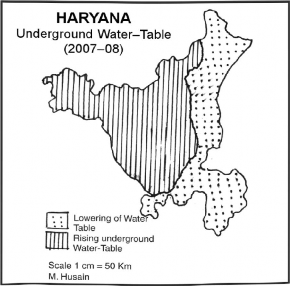5. Lowering of the Underground Water-Table
The I ligh Yielding Varieties of rice and wheat are w ater-relishing crops. Rice, being sown in the low rainfall recording area of Punjab and Haryana, demands severed irrigations and same is the case with wheat crop. The continuous lifting of water through tube-wells and pumping sets has lowered the water Table in the eastern districts of Haryana (Fig. 9.18). Many farmers have to lower their tube-wells in the years ol inadequate monsoon rainfall. If the cropping pattern is not changed, and irrigation of rice and wheat continues at the present level, the underground water-table may not be sufficiently recharged and may get substantially depleted. In opposition to this, the underground

Fig. 9.18 Haryana Green Revolution and Underground Water-Table (2007-08)
water-table in western Haryana is rising as there is a gypsum layer in that part of the state which does not permit the percolation of water through this layer. The watertable in the Jhajjar District of Haryana has risen significantly. The crops of millets, bajra, arhar are damaged. In fact, people in this district pray for drought so that the waterlogged areas may be sown. Consequently, there are water-logged conditions in several tracts in the western parts of Haryana. This rise in the water-table is resulting into capillary action, leading to the occurrence of saline and alkaline formations.
